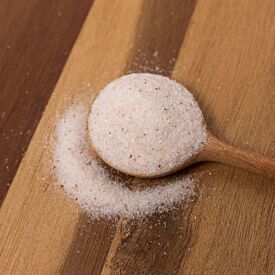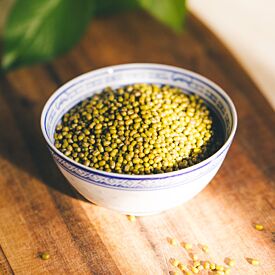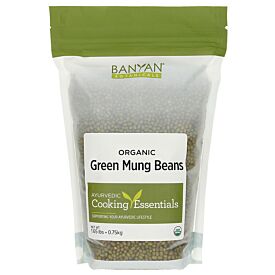All You Need to Know About Sprouting + 3 Awesome Recipes
Sprouts are vibrant, delicious, inexpensive, full of prana, and totally cute. What’s not to love about this high-nutrition food? You can purchase a bag of sprouts at the grocery store or farmers market at a highly marked-up price, or you can simply grow them at home.
Sprouting at home guarantees freshness and decreases cost. While a bag of organic sprouts may cost up to $6, a large jar of mung bean sprouts you made yourself ranges in the $0.90 range, costing about $0.15 per cup. Witnessing nature’s intelligence up close as they grow is incredibly humbling and inspiring, and sprouting can be an entertaining project for kiddos at home.
What Are Sprouts?
Grains and legumes like mung beans and lentils are actually the seeds of their respective plants. A seed contains its own life support system—everything it needs nutritionally to grow into a plant.
As part of a wholesome diet, mung beans are chockfull of protein, vitamins C, K, and A, omega-3 and 6 fatty acids, starches, and more.3 They also contain complex acids and sugars that help the seed survive the digestive tract of animals and humans, known as anti-nutrients.
Phytic acid is a known anti-nutrient, a natural compound that inhibits the absorption of some vitamins and minerals.1,4 While anti-nutrients are not inherently harmful, those with weaker digestion (agni) may notice their impact. They can cause gas, bloating, and may even cause the food to leave the digestive tract intact (check your stool!).
The development of antinutrients is actually a survival mechanism of a plant to ensure their offspring (seeds) can survive and grow where they land.4 The inherent intelligence of plants never ceases to amaze.
There are a few methods that help break down anti-nutrients which are present in legumes, grains, and some vegetables. These include cooking, soaking, fermentation, and sprouting. While soaking is beneficial for removing these hard to digest enzymes for most seeds, the process of sprouting actually converts them, allowing more of the nutrients to be available. In short, they become more digestible.2
Prana-rich foods are considered sattvic, which means they are light and clear. These qualities, when present in foods, are considered easier to digest.
Once sprouted, the mung beans can also be astringent and slightly bitter, which makes them drying and cool. They are the best for reducing pitta and kapha in the body, and may aggravate vata, especially if they are not cooked.
How to Make Sprouts
You can use the steps in this video to sprout lentils, broccoli seeds, and some beans, depending on freshness, as well as whole grains like wheat berries, unhulled barley, buckwheat, corn, farro, kamut, millet, quinoa, and brown rice. They must contain the germ and bran in addition to the endosperm to be sprout-able.
Instructions:
- Take ¼—⅓ cup dried green mung beans, rinse well, and place in a mason jar (or sprouting vessel of choice).
- Add 1½ cups water and soak overnight, then drain and rinse.
- Place under a towel and store in a cool, dark place for 2–5 days, rinsing and draining gently twice daily.
- Once you have your jar of sprouts, rinse them and dry them well using a salad spinner.
Then store them in an airtight container with a small towel or paper towel to absorb excess moisture. They can keep in the refrigerator for up to two weeks, but it’s best to consume them within a week.
3 Nourishing Sprout Recipes
Sprouts lend themselves to an endless variety of tasty possibilities! You can absolutely eat them raw in a salad in the summer, which can be especially balancing for pitta. However, very lightly cooking them makes them more suitable to consume year-round and makes them more compatible for vata.
Here are three recipes to begin to incorporate sprouts into your Ayurvedic diet, and we encourage you to play with adding them to your own favorite recipes as well!

Zesty Veggie Tacos with Sprouts
Serves 1–2
Best for pitta
Ingredients:
- 1–3 tortillas of your choice
- ¼ onion or 2 green onion stalks, finely chopped (green onion is more balancing if you’re really fiery)
- 1 whole carrot, sliced into ¼ inch pieces
- ¼ cup cauliflower, cut into halved florets
- 1 cup sprouted mung beans
- ½ –1 tablespoon coconut oil or ghee
- ½ teaspoon ground cumin
- ½ teaspoon coriander powder
- Salt to taste
- Handful chopped cilantro
- Limes to taste
Optional Additions:
- Add ¼ teaspoon smoked paprika if you have a bit more kapha in your constitution
- Cashew cream or cilantro cream sauce if you have more vata in your constitution
Directions:
On medium-low heat, add the coconut oil or ghee to a pan and add the onion. Sweat the onions with a pinch of salt until slightly translucent—be sure not to let them burn! When they are close to translucent, add the ground cumin seed and coriander, and when the aroma lifts, add 2–3 tablespoons of water to deglaze the pan.
When most of the water has evaporated, add the carrots, cauliflower, and a sprinkle of salt.
Toss to combine, then let sit. When there is slight caramelization, toss again, shaking the pan to help the vegetables settle. Meanwhile, lightly toast or warm your tortillas to your liking.
When the vegetables are al dente, or almost slide off a fork when inserted, deglaze with 1–2 tablespoons of water again. When the water cooks off, add a squeeze of lime juice. Lastly, add a big handful of sprouts to the pan, and toss for 2–3 minutes.
To assemble your tacos, lay out your tortillas and add the vegetables, with more fresh sprouts on top. Sprinkle with cilantro and lime juice and enjoy!

Creamy Cauliflower Rutabaga Soup with Sprouts
Serves 2
Best for kapha
Ingredients:
- 1 cup cauliflower florets
- 1 cup rutabaga, cubed in 1-inch pieces
- ½ cup sprouted mung beans
- 3 cups vegetable stock
- ¼ teaspoon ginger powder
- ½ teaspoon brown mustard seeds
- Salt to taste
- 2 teaspoons ghee or olive oil
- Fresh dill to top
- Enrich with almond milk or cream (optional)
Directions:
In a steamer basket, steam the cauliflower and rutabaga until tender, making sure to not overcrowd the basket.
In a medium saucepan, warm the oil and temper the mustard seeds until they pop. Add the salt and dried ginger, then add the vegetable stock. (You can also add parsley and dill to the vegetable stock for an extra flavor infusion if you’d like). Bring the stock to a simmer, then let cool slightly before moving onto the next step. Reserve one cup on the side for blending.
Using a blender or immersion blender, combine half of the steamed vegetables and half of the stock. If you prefer a more rustic texture, blend lightly. Otherwise blend until smooth. Add some of the mixture back to the saucepan, and then blend some of that mixture with the remainder of the vegetables, using the reserved stock as needed. Once you have your desired consistency, season with salt to taste and return to a simmer.
Lastly, steam the sprouted mung beans for 2–3 minutes.
Serve your soup in a wide bowl, topping with a drizzle of ghee, fresh dill, and steamed, sprouted mung beans.

Hearty Grains Sauté Bowl with Sprouts
Serves 1-2
Best for vata
Ingredients
Grains:
- ¾ cup brown or basmati rice, or a mix of the two
- 2 cups vegetable broth or water
- 3 slices fresh ginger
- 1 teaspoon cumin seed
- 1 tablespoon ghee
Homemade Ginger-Tahini sauce:
- 4 tablespoons tahini
- 1 teaspoon ginger powder
- 1 teaspoon salt
- ¼ cup apple cider vinegar or lemon juice
- 2 tablespoons olive oil
- 1 teaspoon maple syrup
Toppings:
- ½ sweet potato, cut into chunks
- Handful of chopped greens, such as chard or kale
- Chopped green onion
- Sprouted mung beans
Directions:
To make the rice, dry toast the cumin seeds then add the brown rice and toast for 2–3 minutes.
Add the broth or water and bring to a boil, then cover and simmer for 15–20 minutes. If you are using a mix of brown and basmati rice, add the basmati rice and the ginger slices, along with ¼ cup more liquid if needed, then simmer and keep covered until cooked. Let sit for 10–15 minutes, then fluff and set aside.
To prepare your toppings, steam the sweet potato first for about 10–15 minutes. When almost entirely cooked, add the chopped greens and mung beans. Watch your hands, the steam will be very hot! Continue to steam for an additional 5–7 minutes.
Make the ginger-tahini sauce by mixing all ingredients together and blending well.
To serve, spoon rice into your bowl, adding more ghee and salt if desired. Add the steamed vegetables and mung beans, then drizzle generously with the ginger-tahini sauce.










